#its-tricky-to-save-baldurs-gate
Explore tagged Tumblr posts
Note
I got BG3 request in my head for sometime. Um how would Astarion, Halsin, Gale, and Shadowheart react to a s/o or a tav that has a dog that fights along side with them like a tibetan mastiff, or a Akita, or maybe some other breed that is known to be made as guard dogs and protective of their owners? Maybe the dog more or less tolerates the LIs but still keeps an sharp eye on them. (Especially Astarion XD)
Fandom: Baldur's Gate 3
Character(s): Astarion, Gale, Halsin, Shadowheart
Note(s): I have watched videos on the LIs reacting to Scratch and Astarion's reactions always kill me (and make me cry the most). I'm happy to write this for you!
WARNING: Mentions of Dog Being Injured in Combat

Astarion
Considering his interactions with Scratch, he'd also act very indifferent when it came to your dog. Sure, it's a great meatshield, but it's a stinky animal.
Astarion is constantly telling you to just leave your dog at camp, acting like it gets in the way and is a nuasance, but he just doesn't want to see it being hit by a spellcaster or shot with an arrow. If ANYTHING bad happens to this dog then he'll lose it.
Honestly offended that your dog is indifferent to him. As if he hadn't been collecting the bones of your enemies to gift to the furry mutt. Very rude.
Gale
He's more of a cat person, but he loves you so he doesn't mind your dog. Although, he can't help remarking that your dog knows he likes cats considering how your dog is very indifferent to the wizard.
Gale makes sure to give your dog some good treats and headpats when he goes to spend time with you. He knows how much you and your dog have been through and he's going to thank the doggo.
Okay, but while Gale is more of a cat person, he can very much appreciate how pretty your dog is. He insists on giving your dog baths to keep its coat shiny and not bloodstained as many battles tend to leave you all.
Halsin
Oh Halsin absolutely loves your dog. It's a very strong breed and the gooddest boy/girl (besides Scratch) and he would love to cast a Speak with Animals to speak to your protector.
Your dog being indifferent towards Halsin does cause him to chuckle a bit. He promises that he'd never think of stealing you away from your precious companion and instead thanks your pupper for keeping you safe for so long.
Halsin enjoys wrapping you in one arm while his other is brushing your dog. The last thing he (and you) want are your dog having mats in their fur due to all the constant travel and battling you all somehow end up in.
Shadowheart
Like Astarion, she is also very iffy about you bringing your dog into combat situations. She understands that your dog is very loyal and keeps you safe, but she worries about something going wrong.
You can't always prepare for when someone wants to stop talking and switch to stabbing and she'd hate for your dog to get in the way. She knows your dog is indifferent to her, but she really hopes your dog also knows that she will keep you safe while the little guy is safe at camp.
Besides that, she does try to pet your dog and give the little guy plenty of loving too. Your precious dog will get all the praise for the goblins it ripped apart for you.
#its-tricky-to-save-baldurs-gate#bg3 x reader#astarion x reader#gale x reader#shadowheart x reader#halsin x reader#astarion ancunin x reader#gale dekarios x reader
271 notes
·
View notes
Note
I admit I'm thinking of after I play as Liriel Baenre, I'm going to play as Zaknafein Do'Urden next, poor dude is not getting a break. Its also an excuse to write a FGR au for him where he's does come back to life in a different way and had to leave the Underdark. Then he got captured by Mind Flayers lol. For Liriel I'm debating to whatever or not have her romance Gale or Karlach. For Zaknafein I'll keep him single after everything he went through with Malice he needs time for himself.
oh awesome! I think playing as Zak would be so fun!!
I haven't finished the Liriel books but I think she would have so much fun with Karlach (also maybe she likes barbarian's lol) buuut the potential of nerding out over magic with Gale is good too!
If you don't already follow them, @lawful-evil-novelist is doing a really fun playthrough with the Do'Urden family in BG3. I always love reading their posts about it.
3 notes
·
View notes
Text
Halsin/Astarion (Baldur's Gate)/ Gender Neutral Reader - Kissing Lesson
Give it up for my 100th fan fic on AO3!! (๑•̀ㅂ•́)و✧ Plus I'm really feeling this ugly fine wood elf. You can also read it here on my AO3.
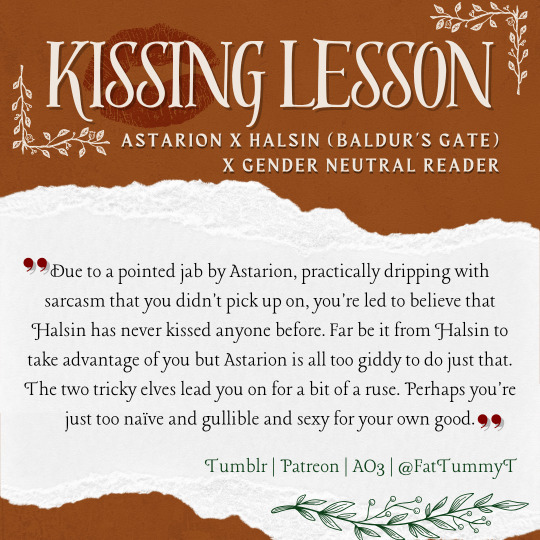
Summary: Due to a pointed jab by Astarion, practically dripping with sarcasm that you didn't pick up on, you're led to believe that Halsin has never kissed anyone before. Far be it from Halsin to take advantage of you but Astarion is all too giddy to do just that. The two tricky elves lead you on for a bit of a ruse. Perhaps you're just too naïve and gullible and sexy for your own good.
Your laugh interrupted their conversation, "You've truly never kissed another mortal soul? I find that incredibly hard to believe, Halsin."
"What can I say? Kissing is an intimate art." He shrugged. "Fooling around is a much more natural experience. Primal and instinctual. Whereas kissing is delicate, learned, unnecessary... Or perhaps I'm just saving myself for the right one."
"Hogwash. Come here, I'll teach you how to kiss." You gestured him toward you.
Astarion reacted before Halsin, a glimmer in his eyes as his lips curled into a hesitant smile, continuing the bit. "You'd be so kind as to impress your lips upon him and teach our dear Halsin here how to kiss?"
Halsin hadn't yet responded, though his mouth hung open slightly as he stared between you and Astarion.
"Don't treat it so highly, Astarion. Kissing is just as natural as mating is, and holds no special significance. You can kiss another and feel absolutely nothing. I'll prove it."
"Do you hear that, Halsin? Y/N is—” Glancing over at the larger man made him burst into a fit of laughter. "You practically look like a tomato patch, Halsin!" Astarion laughed. "I didn't know you could still get your blood to flow that high given your advanced age. Do you need to take a seat, my comrade?"
"Hush, Astarion." The larger man muttered, brushing his pale hands away from its resting place on his shoulder. "I appreciate your kind gesture, Y/N. But we're only speaking in jes—” “—It would seem our gentle giant of a man here is far too humble to say yes to such a genuine offer from such a saccharine sweet morsel as yourself.” Astarion stepped forward, taking your hand. “Here, allow me to partake. Perhaps I can learn a bit from indulging in your sweet lips and tongue—”
It was Halsin who grasped Astarion’s shoulder this time, with great ease, shoving the lithe lecher out the way. “I'm afraid we're all aware of just how much practice you've had. In fact we hear your sessions with our fellow party members every evening.”
All except you, that is.
Astarion almost barely managed to recover, making it to his feet and readjusting his now messied blouse. “One can never miss an opportunity to brush up on our skills, I say.” He muttered, dejectedly.
“So you'd like to learn then?”
Halsin smiled now, a greater sureness in his voice as he spoke this time. “It'd be an honor to learn at your hand.”
“Enough with the dramatics, I'm just teaching you about a simple kiss, not how to wield a blade.”
“I'd care to witness that too.” Astarion muttered to himself.
You rose to your feet in front of Halsin now, standing just a few heads shy of his great height.
“Ah, your height I hadn't taken into account. Well, no matter.” You took to standing atop the tree stump you'd previously used as a seat, Halsin joining you there.
“Kissing is quite simple, really. Your main concern should be ensuring you don't accidentally bump noses with your partner.”
“Luckily for you, you've no horns or muzzle, but these are all small details to take into account as they affect how you might kiss.”
“A muzzle, eh? Hope you aren't planning to turn into any beasts anytime soon, Halsin?”
“Not if I can help it.” Halsin muttered.
“Hush, Astarion! I'm teaching!” You answered back. “Luckily for you, it's quite easy as you have very slight and unassuming lips. There's less worry of messy or wet kisses starting out.”
He raised an eyebrow, a suggestiveness to his voice. “Is messy and wet unpleasant?”
“Not necessarily. Though, since you're only just a beginner, it's best to start simple.”
“A wise choice.” He nodded, staring down at you. “Though I assume having fuller, rounder lips such as yours, might make kissing more pleasurable?”
“The emotional connection between two partners is what carries the most significance. Lips, mouth, or muzzle. Physical attributes are secondary to that.”
“Fascinating. Please, continue.”
“I don't think this part requires quite as much verbal instruction. You'll have to learn by doing. Kissing is unique to every person you kiss, made better by small actions like holding them, or stroking their hair or some such—”
He stroked his right hand along your cheek, resting at the crux of your shoulder and neck.
You laughed, an awkward tension rising in your gut. “Yes, like that.”
You cleared your throat, “A few pieces of advice before we dive in, however, are to keep your lips relaxed and soft while kissing. And to lick your lips, to ensure your lips aren't dry.”
His tongue darted out across his lips slowly as you spoke, slightly scrambling your focus. “Y-yes, precisely that.”
Astarion had quietly and slowly maneuvered his way into Halsin's peripheral, hand resting under his chin as he watched with quiet intensity.
“Now, do you have any questions?”
“I'm a bit nervous, I'm afraid to admit.” Halsin chuckled, glancing between your lips and eyes. “Perhaps you could close your eyes before we begin?”
You laughed now, so pleasantly surprised by how adolescent he seems. “You're adorable, Halsin. But yes, of course I can honor your request.”
Closing your eyes now, you had trouble ridding yourself of the smile and snickers that bubbled out of you. “Gods, I feel so juvenile. I’m just… amused by this situation. Please, just ignore me.”
“That's no worry.” Halsin answered, his other hand stroking down your forearm. “This is quite unfortunate, isn't it? Teaching a man more than a century your senior how to kiss?”
Your hands rested on his shoulders now, steadying yourself. “You'll be fine at it, Halsin. Kissing is as natural as mating once you have the experience—”
A shocked squeak exited your parted lips as his mouth met yours, his grip on you tighter, firm, as his thumbs rubbed idly along your skin.
Astarion watched with bated breath as your eyes shot open, alarmed, before quickly fluttering shut.
Sinking into you now, he tilted his head to the left, capturing more of your lips he'd missed during your initial interruption, sighing through his nose as you fell into rhythm with his motion now.
Your nose was soft against his as you dragged your tongue along his lower lip.
“Like that?” He smiled in between kisses.
Your hands cradled his jaw now as he pulled you to his chest at your shoulders. Not an inch of space shared between you now as you both quietly moaned and giggled.
Astarion cleared his throat, tapping his foot impatiently, as you both continued.
“You’re quite talented.” You whispered into his mouth.
“Ahem!” Astarion repeated, snapping you momentarily out of your punch-drunken stupor.
“Oh—” You pulled back, only for Halsin to lean in again, capturing another quick peck before releasing you.
“It appears Halsin is a much quicker learner than he initially appeared to be.” Astarion trilled.
“Perhaps it came naturally to me, after all.” Halsin answered, his eyes never leaving you.
“Hmm! I believe I recall a naïve little birdie once saying, You can kiss another and feel absolutely nothing. I'll prove it.”
Logic, reason, and blood flooded back into your brain from your loins now causing you to make a sudden realization.
You gasped, “You hedge-born— loggerhead!” batting Halsin on the shoulder. “You lied to me!”
They both burst into laughter now, Astarion nearly doubled over in joyous revelry. Halsin did little to evade your continued shoves and smacks, save grabbing you into a hug.
“My apologies for leading you on. But Astarion's influence was far too enticing.”
“I mean honestly, did you truly believe a being as old and as striking as Halsin had never been kissed before? Surely you must’ve known we were taking the piss.”
“I have half a mind to blemish that pearly white skin of yours with a mallet.” You spat.
“Oh come now, there’s no need for violence, love. Perhaps I can initiate an apology with my lips?”
As you advanced upon him, you were met with the warm and gentle grip of Halsin tugging you by the hand.
“All jest aside, Y/N, I thoroughly enjoyed that experience.” Halsin’s brows curving, eyes in a half lidded gaze. “You're a talented instructor. And should you care to continue practicing with me, I'm always open to the opportunity.”
“Halsin, I—” “—If you do so, please do invite me! I’d be more than happy to watch.” Astarion interjected.
“Enough. Both of you.” You started, pulling away from Halsin's lingering grasp. “I'm more than capable of initiating intimacy without the guise of education, as you'll both come to learn, should you behave properly from this point forward.”
“Oh.” Both men peeped.
“I'm done with your shenanigans for tonight. Now I have some unmet needs to satisfy. Alone. Kiss each other if you must.” You turned heading back in the direction of your campsite.
The two sat uncharacteristically quiet for a moment, Halsin looking ever so dazed and dreamy still.
Astarion sat down at your abandoned stump now, crossing his knees. “It appears my playful meddling might have had some unexpectedly positive effects.”
“As much as I wish that you’d put your manipulation talents to good use, tonight I've made an exception. You’ve made an expert wingman, Astarion.”
“Shall we retire back to my tent for the remainder of the evening, beast man?”
Halsin offered his hand, helping the smaller man up to his feet. “Take the lead.”
“I always do.”
Thank you so much for reading! Sorry if they seem out of character, I've never played the Baldy's Gape and have only seen the infamous forest sex scene and the ahem ... Drow fivesome.

Check out my Patreon here and find me online elsewhere by visiting my website here!
#baldur's gate 3#bg3 astarion#bg3 tav#bg3 halsin#fanfiction#baldurs gate astarion#baldurs gate tav#baldur's gate halsin#halsin#astarion#halsin x tav#halsin x reader#halsin x astarion#I would climb that man like a tree#suggestive#couple kissing#bg3 fanfiction#bg3 fanfic writers#baldur's gate fanfiction#is this too many tags? did anyone even read this far?#I don't even go here. I'm just downbad for the wood elf.#my fanfictions
47 notes
·
View notes
Text
Ask prompt fill for @astreamofstars for this ask meme: The Deeper the Water Dialogue Prompts Minsc - "You can be mad at me as long as you need to be" In a throwback mood lately so here's some BG2 feels. c:
-----
Caden: This isn't real, is it? He couldn't be dead… Jaheira: Shut up! No more words! Words are nothing! Yoshimo: I knew him not, but I mourn for your loss. Jaheira: Stranger! Nobody! I will not hear your words! Leave me! Minsc: A brave man has fallen here, but that is no cause to hurl insults at the living. Here, Boo shall comfort you. Jaheira: Imbecile! Affront to nature! What do you and your rodent know? What can you know? No words! No more words! Save your speeches, save your proverbs! The only voice I wish to hear is… is dead! No more! No… No…
- Baldur’s Gate II
---
“So this is Amn, eh, Boo?” Minsc looks around at the richly painted walls of his room at the Mithrest Inn, his eyes bright with disdain and exhaustion. “Minsc does not think it very much to look at, in spite of all the shiny baubles upon the walls.”
He examines a piece of art set over the headboard of the bed, and then shakes his head. “No. You may paint and daub all you wish, Athkatla,” he growls. “But Minsc shall not forget that his arrival within your walls was bought with blood.”
The artwork does not respond.
Minsc sighs. “Yes, yes, Boo. You are wise as always, to say this changes nothing. But if a berserker is without his wychlaran, what has he left but rage?”
He rests a hand inside his pocket, feeling the comforting nuzzle of the hamster’s head against his palm. “Well,” he amends, “rage and you, of course.”
He should sleep. Much lies ahead of them all, now that Imoen has been taken and Irenicus yet lives unpunished. But it is hard, so hard, to sleep in a room where Dynaheir's breath no longer sounds nearby - the distinctive hitch on the inhale, the occasional mumble of arcane words that meant nothing to him. He feels her absence like the phantom pain of a ripped-off limb.
He leaves the room, prowls the hallways of the inn like a tormented ghost. Caden has already gone to sleep, and the thief from Irenicus's dungeons as well, but Minsc is surprised to find, on reaching the tavern at the front of the building, that he is not the only one still awake. Jaheira sits in a dark corner of the nearly empty room, watching with hooded eyes as the innkeeper wipes down the bar. A large glass of ale sits in front of her, untouched, its foam long since subsided.
She looks up warily at the sound of Minsc's heavy footfalls. “Do you come to bring me yet more platitudes, ranger?”
Minsc says nothing for a moment. He still remembers her sharp, angry bark in the catacombs where they found Khalid, the pain in her voice that answered his own. “If to rage at Minsc again would bring you comfort, Jaheira, perhaps he may find some good words to offer,” he finally says slowly. “But he has spent all those that came easily, and what remains is little indeed.”
Jaheira looks away from him and fidgets with the base of her glass, absently rubbing a line through the condensation that has formed there. “I am sorry, Minsc,” she says.
“There is no need--”
“I think there is.” She looks up again, and there is a sudden fire in her eyes. “I am no fool, who cannot tell when her shots have gone wide of the mark and struck those not the target. If you grant me the luxury of misplaced anger, grant me also this apology.”
A pause. “Very well,” he says. He reaches out and places a hand on the back of the chair opposite her; when she doesn't object, he sits, his heavy bulk causing the wood to creak. He can feel the familiar scratch of Boo shifting position as his pocket flexes with the motion.
Jaheira watches him, then nudges the glass in his direction. “If you desire flat ale, you are welcome to this,” she says, with muted irony. “I ordered it, but I find I have no taste for it.”
He can understand this. Oblivion, he has found, can sit at the bottom of a glass, but it is a tricky thing; sometimes in falling towards it, one can miss and land instead only in deeper sadness. He shakes his head. “I thank you. But no. Minsc would rather feel this thing that tears at his insides, because not to feel it would be worse.”
“Yes,” she agrees. A pause. “I am sorry about Dynaheir. Her loss is a tragedy.”
“It is. Minsc shall not see her like again.” He examines a knot in the wood of the table. “She thought well of Khalid,” he adds abruptly. “Many times Minsc heard her speak of his bravery and kindness both. And Dynaheir saw only what was true.”
Jaheira smiles shakily. “Khalid and I both found her a fine companion in turn,” she says softly. “She was as strong in wisdom and magic as any I have encountered. We-- I am the richer for having known her.”
“And the world the poorer for having lost her.” Minsc makes a valiant attempt to smile but the muscles of his face twitch with the effort. “Even now, I feel that I might turn my head and see her watching,” he mutters bitterly. “Minsc’s mind mocks him with wishing.”
Jaheira squeezes her eyes shut and rests her elbows on the table, leaning her forehead against the heels of her hands. “As does mine,” she murmurs. “We had no time to prepare ourselves for this blow. It struck without warning and tore our hearts out of us.” Her breath catches, as if someone has struck her in the stomach. “How shall we bear it?” she whispers, more to herself than aloud.
Now Minsc does smile, utterly without humor, a savage expression showing all his teeth. “We shall sink our boots into the butt of he who took them from us, so deep that we shall kick out his guts.”
She snorts softly and lifts her head. “Wisely said, if indelicately,” she says. She breathes out heavily, her shoulders squaring, her fingers balling into fists. “We shall destroy Irenicus indeed, and if fate is kind I shall land the killing blow myself.”
Minsc's smile draws very tight; it gives his high forehead and cheekbones a distinctly skull-like aspect in the lowering torchlight. “If fate is kind,” he growls in answer, “you shall indeed, and Minsc shall break every one of his bones, that he might not run away from your blow. Nor shall he see it coming, for Boo shall chew out his eyes.” He brings down his fist on the table with a bang that makes Jaheira jump. “And so shall dear Dynaheir be avenged, and Khalid as well.”
“Yes…” Jaheira murmurs, and for a moment there is a glint in her eyes that reminds him all too clearly of the tiger she is capable of becoming. “Silvanus lay the path, and Mielikki guide our hunt.”
#ask meme#astreamofstars#Minsc#Jaheira#BG2#baldur's Gate 2#hope you like! ty for the prompt as always friend c:#I both enjoyed writing this one and gave myself feels XD#we've speculated a bit on Jaheira and Minsc having more time becoming friends in BG2 than the game shows up#so getting to work on adding that to the tapestry :D
16 notes
·
View notes
Text
How to get an Abdirak of your own!
Here are some mods you need if you want Abdirak (or any other NPC really) to travel with your party!
Abdirak as an NPC companion
Recruit any NPC is the first mod you need. For those who are new to modding, here's how you can install it. First you need the software that this mod requires to work:
Get the Norbytes script extender. Unzip the archive, put the extender's 'DWrite.dll' file into your '[Steam folder]\steamapps\common\Baldurs Gate 3\bin' folder.
Get the BG3 Mod Manager. Unzip it, launch it, go to the Preferences and link your game's exutable and folder in its settings.

Download the mod itself, unzip, drag the 'RemoveMultiplayerCharacter.pak' file into you Mod Manager's 'active mods' leftside field, then press 'save'.

It gives you this wonderful ability:
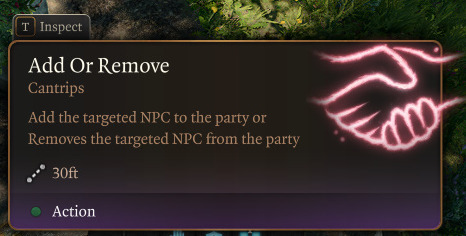
Get to the goblin camp, target Abdirak with it, and he will become your companion!
He still can be interacted with as well, so if you wanted to take some screenshots in a more scenic environment, now you can. (The penance itself is bugged though. I was able to reenact it once near the bloodstained chapel's wall, but it's not guaranteed. More testing needed. Do it before you aggro the whole goblin camp, as per usual, cause he will try to leave the camp (and the game) after if you're anywhere close to the goblin camp.)
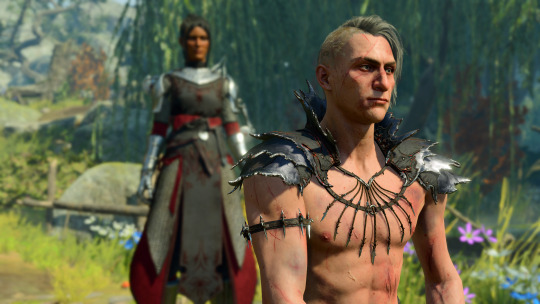
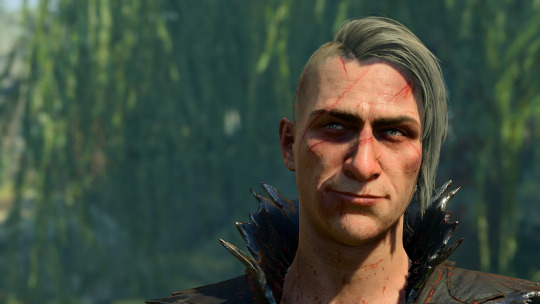
The only problem with this method is that he's still an NPC, he can't be leveled up (and he doesn't have much in terms of abilities), and the gear doesn't show up, so if you want to take him through the rest of the game, he won't fare well.
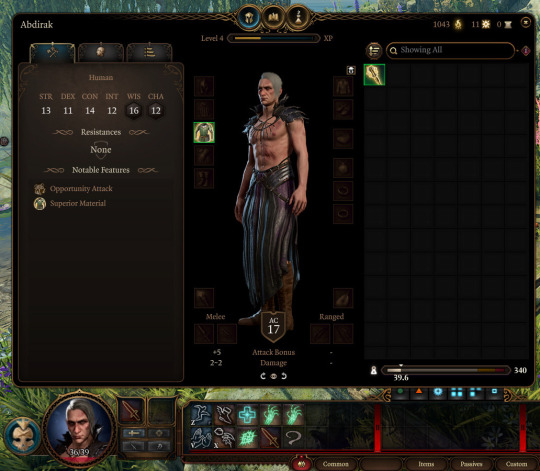
So if you want to have a functional cleric with you, you will want:
Abdirak as Tav
First, you need a second Tav. Getting a second player through multiplayer is an option, but the Recruit any NPC mod we already installed gives you a second ability:
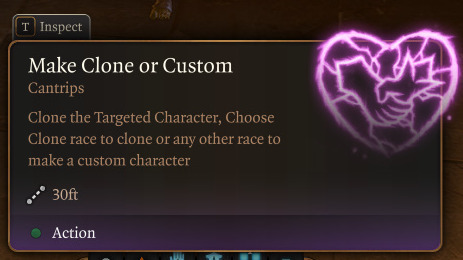
Target Abdirak, and you'll be taken to the character creation screen to create a second Tav for you to control. There, you can select the 'Clone' option when you choose the race. It'll give you an Abdirak that CAN be leveled up and has the selected class's abilities, but his visuals still can't be changed.

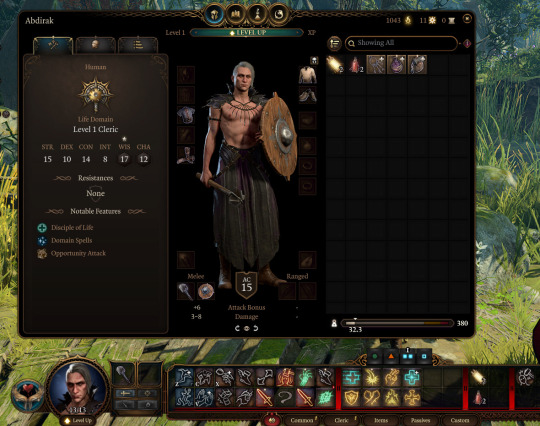
If you want an Abdirak who can wear gear that will show up on him, we need more mods (also, you don't have to target Abdirak when you create a second Tav. Target anyone, so you can have Abdirak from the very start of the game). @sweetmage has already made Abdirak as the main Tav, but he lacked the body scars. Let me rectify that!
The Customizer's Compendium modwill give you Abdirak's face (drag the 'Customizer.pak' file into the Mod Manager; you also need the ImprovedUI mod for it to show up properly, place it under the Customizer mod in the list) , facial scars included. The hair is already in the game, the colors need to be eyeballed. Here's a closeup of the NPC. In my estimation, he's got Cool Tone 5 for his skin, Solid White for his eyes, and Grey 1 for hair, but YMMV.

The body scars are a different matter. If you're playing as a human/elf/drow/half-elf male Tav, there's currently no way to give Abdirak his scars without also giving them to your Tav. If you don't mind, or play a different race, or if you're playing a female Tav, you will need:
Unique Tav (as well as Trip's old shaderpack for the mod to work, drag it into the Mod Manager). It's a bit more tricky to set it up.
- Find in the mod's 'Files' section, download and install with Mod Manager the 'Unique Tav PAK'.
- Download 'Unique Tav Data', unzip, and manually put the 'Generated' folder inside of your '[Baldur's Gate 3 steam folder]\Data' folder.
- THEN download the 'Unique Tav Body Variants'.
- Find the 3 filed inside of the 'body_variants\NORMIES\male_hairy_lovitar_actually_hairless' folder you just downloaded.
- Copy these files to your '[Baldur's Gate 3 steam folder]\Generated\Public\Shared\Assets\unique_tav\BODY\NORMIES\MALE' folder, replace the files that are already there.
Ta-da! Your Abdirak (and human/elf male Tavs) will have the body scars!
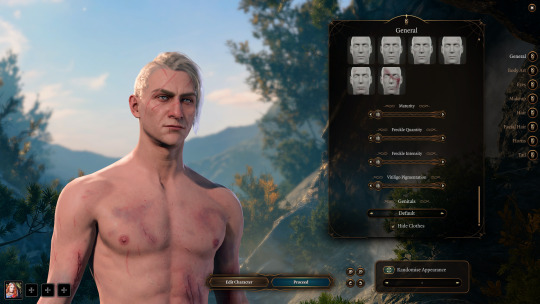
Not on their legs though. If you want that, you will have to edit the texture files yourself.
You can download a tutorial on how to do that over at Many scars for unique Tav. You will need Photoshop (and knowing how to use it), a Photoshop plugin to open dds files, and a bit of creativity (or, you know, you can just take the scars from this mod and replace Abdirak's leg segment).
Edit UNIQUE_M_NKD_BODY_A_NM to add texture.
Edit UNIQUE_M_NKD_BODY_A_HMVY to add color. I'm still working on the latter, but I can upload my files sometimes later when I have it, if anyone's interested.
If you want his outfit, you need the Basket full of equipment mod (install with Mod Manager, read the mod's rescription to learn how to gain access to the basket), the clothes are in the 'exotic gear' bag. If you want that outfit as camp clothes, you also need to install the Basket Equipment to Camp Clothing mod.
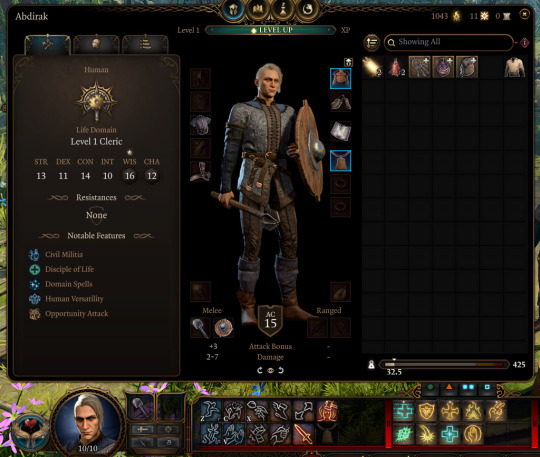
That should cover it. Let me know if you have any questions, I'll try to help!
27 notes
·
View notes
Text

Day 1: Date Night
by @its-tricky-to-save-baldurs-gate. A preview to Magic Cat's fic for a romantic, date night with Wyll Ravengard!
You can read more here:
#wyllweek2024#love wyll event: wyll week 2024#wyll ravengard#bg3 wyll ravengard#baldur's gate 3#bg3#baldur's gate 3 wyll ravengard#baldur's gate iii#baldur's gate iii wyll ravengard#bg3 wyll
8 notes
·
View notes
Text
@herdarkestnightelegance <3


Little diabolical ball of chaos - me!
Music - don't judge me ok, raves help me focus while working ~
Tagging: @its-tricky-to-save-baldurs-gate, @housenightstar
Tag game
this picrew + the last song you listened to :]
@prettymuchteddy thank you for the tag😉


Partly based on myself:)
Tagging (no pressure) @very-straight-blog @dr-aegon @liv-cole @vhagar-balerion-meraxes @thesunfyre4446
@sidraofthewildflowers @ladystarksneedle @wolfdressedinlace @vipervixxen @aegon-the-elder
171 notes
·
View notes
Text
Part 93 Alignment May Vary: A Series of Side Quests
ALast time, I introduced the concept of how I’m handling the pre-final battle side quests, which will influence how that battle goes. I’m taking a lot of direction from the RPG Blades in the Dark for this, which I highly recommend as a must-read for any DM who wants to take their game to the next level. Even if you don’t end up playing Blades in the Dark, the way it presents how to run a satisfying game and how to keep your sessions focused on actions, obstacles, and consequences, is incredible reading. For these side quests, I’ve really drawn on its lessons a lot in order to keep the action focused and our story moving. If I didn’t, the five missions I’m going to cover in this post could have taken us months to play, as we explored dungeons, fought various combats, and had downtime between each quest. As it is, we do all five of these (plus the one from the last blog post) in a single large, six hour session. In that time, the players roll a ton of dice, but we don’t run a single combat... though they overcome many many obstacles along the way.
Here, then, is a brief rundown of each of our little “side quests.” This is a long post, so enjoy!
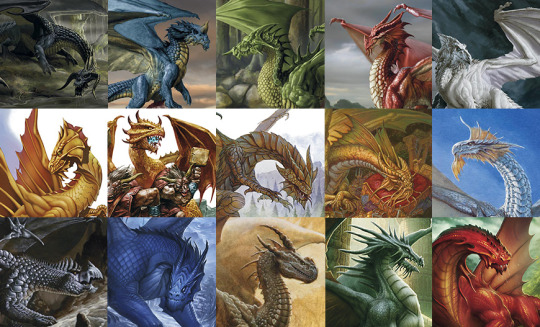
Dragonmeet
Argent, their bronze dragon ally, tells the PCs that they need the support of the dragon council if they are to fend off Abenthy. The PCs agree.
The journey from Waterdeep to the Nether Mountains is more than six hundred miles. For three days, Argent flies you north, passing overhead many signs of ruined cities and villages. No people remain, but neither is their undead or monsters. Abenthy’s influence is silently spreading, and as it does, it is erasing this world of life, leaving nothing behind.
Arriving at the Nether mountains, the PCs are given audience by the council of the great Metalic Dragons. This is a scenario lifted out of Tyranny of Dragons, in a nod to our original planned adventure, four years ago. But whereas in that campaign, there are specific things each dragon wants, here I leave the direction of the conversation more up to the PCs. All three of them make a plea, roleplaying out the conversation, with me playing the dragons. Milosh focuses on his life in Eberron, and the fact that dragons have disappeared from his world and their guidance is greatly missed. He fears Abenthy would see everything destroyed, them included. Carrick compares the dragons to Primus, in their greatness and glory, and says that in a way people are their creations and begs them to make the decision to protect life. Imoaza’s plea is full of regret for the path her people, the Yuan Ti, choose to follow, and says that the dragons are right to judge people not worth saving in the past. But she promises that if they are saved, she will make the effort worth it in the future.
These pleas move the dragons, and they agree to give aid, on one condition: that when the war is over, the Yuan Ti turn to worship of them, and follow a better path.
Imoaza agrees to do this, if she can wrest her people free of their current leader, her son, Xaxus.

An Icy Reception
The PCs decide they need the assistance of the Ice Barbarians in order to fight successfully in the frozen plains of Friezurazov. Also, they will not abandon them to slavery, which which be their fate if the PCs do not intervene.
Argent flies you across the Moon Sea, until you come across a line of Prison Ships. The moon shines down upon them, and upon the head ship, named The Re-Enlightenment, and captained by Gregor Tolman, whose great grandfather once captained The Enlightenment, lost at sea ages ago when it fell befoul of a plot involving the Red Hand. Among its final passengers were Shando, Daymos, and Karina...
The roll to set this quest up goes really well, so I actually cut out an encounter I had planned with the Tarasque, summoned into the ocean by Abenthy to destroy the Barbarians before the players can recruit them. Instead, the PCs reach the ships before Abenthy realizes they are going after the Barbarians, and so this encounter comes down to another roleplay moment, with the PCs having to convince Gregor Tolman to give over the Barbarians to their care.
To do this, I really enjoy the plan the players come up with. Imoaza poses as a haughty noble who says she represents Nakir, their noble ally from Waterdepp, and says he wishes to buy the slaves... all of them! With the help of some magic and good persuasion rolls, they convince the captain to turn the ships around and drop the Barbarians off at the old sea elf post, then go back to their sailing. Gregor is a little suspicious, but they play upon his fears of nobility and convince him not to get wrapped up in their political games. Believing he is in over his head, he follows orders and leaves.
The Ice Barbarians are secreted away in the forests around Waterdeep. Orcaheart, in particular, is overjoyed to have the chance to fight again alongside Milosh and promises that their final drive against Abenthy will “shake the very heavens.”
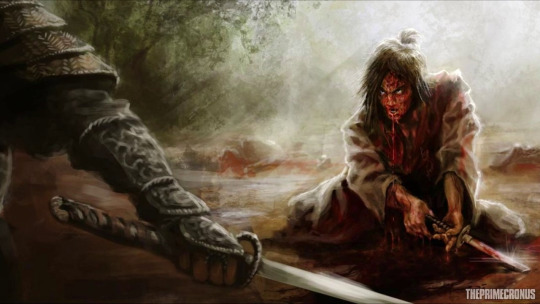
Death Pact
One character that the players are very concerned about is Verrick, the four-eyed Tiefling and former lover of Karina. He is a long long term NPC, and so the players have a personal connection to him. Also, he has become a Death Knight, under the control of Nazragul. While that control seemed to be broken at the Maakengorge, the news that he may be returning to Abenthy’s side is a concerning notion, as he is quite a deadly foe.
You catch up to Verrick at the ruins of Baldur’s Gate, where you find him sitting on a fallen statue, head in his hands. He looks up wildly as you approach and gets to his feet, waving a hand at you as if to push you away.
“Stay back,” he warns. “I do not know how much longer I have control of myself and I would not want to hurt friends of Karina’s.”
It is easy to convince Verrick to fight against Abenthy, but the problem is that Verrick is magically bound to Nazragul’s soul, and has a deep connection to Karina and Abenthy as well. With the three combined in one body, he is finding himself drawn back to fight for him.
Verrick says that, as a Death Knight, he is doomed to be bound to another’s soul until such time as all bounds are broken. Even death cannot stop him while his binder lives, he says. But if they can defeat him now, he will not reform for some time, and will not be able to fight against them in Friezurazov. He prepares to duel them...
... but the PCs have other ideas! I really like how the PCs solve this one. Milosh decides to try and unbind Verrick’s soul from Nazragul and bind it, instead, to himself, thus meeting the requirements of the Death Knight’s contract, while actually winning him over to their side for the final battle!
It requires Imoaza’s mastery of the weave to pull off, and carries a significant risk of killing Milosh, but in the end the players manage to roll through it, and Verrick’s soul, while not freed, is at least bound to the force he wishes to fight alongside.
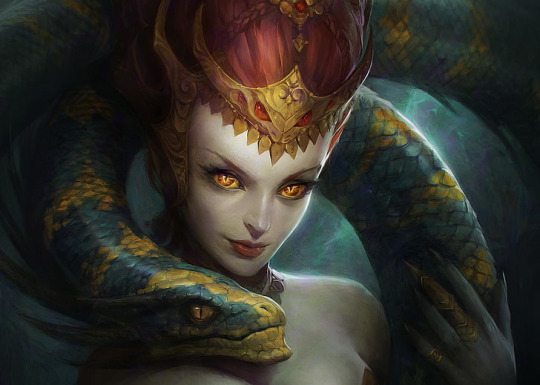
The Wayward Daughter
This is a tricky one. Imoaza receives word that Hecate is being held at Spiral Tower, an underground fortress where the Yuan Ti torture and brainwash those who have “left the fold.” Hecate’s treachery has been discovered, and she is about to go through a re-education program to make her, once and for all, a thrall of her brother, Xaxus.
Imoaza’s thoughts turned to the daughter whom she had abandoned so many years ago, and who had spent so long trying to kill her. Their reconciliation on the Abyssal plane had changed both of them and Imoaza felt that if she did not save her daughter from the clutches of the Yuan Ti now, they would be forced to face each other one final time on the battlefield, and this time one would not walk away.
This mission goes wrong from the start. A bad set up roll means I actually add in an extra challenge. Argent is flying them to Spiral Tower when he is spotted by the magical sensors of the Yuan Ti. A magical storm immediately forms to swallow the dragon and Argent has to abandon the mission. The PCs use the fly spell to drop from his back, fly through the storm, and land in the forest that grows above Spiral Tower.
They waste no time in quickly preparing their plan. This is a bit of a heist mission, involving teleportation magic. Carrick and Imoaza are going to be teleported by Milosh to a precise location in the tower, where Hecate is being held, and then try to get her out. Anyone who knows teleportation rules knows there is a huge risk here: Milosh has never seen the inside of the tower, and is forced to operate off of what Imoaza can describe to him. This leads to some tense rolls, which could result in an instant death scenario for the PCs if they fail. They do not fail, however, and Carrick and Imoaza reach Hecate’s chamber via portal.
Their time is short. Carrick begins dispelling the magic that is rewriting Hecate’s personality and thankfully the process is not far enough along to have changed her, yet. Hecate comes up with a daring plan. Rather than leave with Imoaza, she suggests that she stay behind and pretend to have been indoctrinated. Then, when the moment is right, in the final battle she will turn and strike Xaxus down.
Imoaza agrees, and tells Hecate, too, of her plan to join the Yuan Ti to the worship of the dragons. She says to start spreading the word of the dragons through the Yuan Ti as subtly as Hecate can, so that the Yuan Ti begin to believe the Dragons are their true saviors. Her hope is that when the dragons arrive on the battlefield, it throws the Yuan Ti forces into disarray and opens up a path to Xaxus.
Imoaza half expects Hecate to question this new direction for the Yuan Ti, but Hecate says that Imoaza will always be her leader and will be trusted in all things. Then she tells them to go, before Milosh is discovered. As they leave through the portal, Imoaza finds herself concerned for the first time in her life with the safety of a family member, and finds the emotion both beautiful and strange.
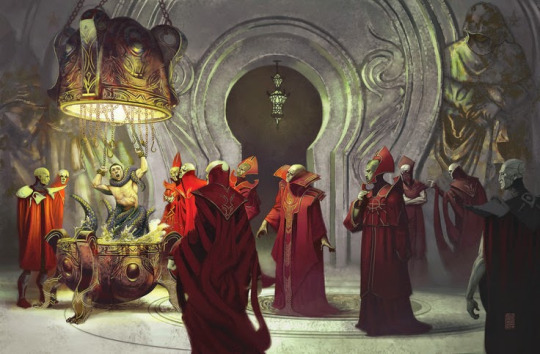
The Wizards of Thay
The final side quest involves finding Daymos and helping him recover Jade’s soul. The roll on this one is not great, and so the PCs find no trace of the psychic-turned Quasit. However, they do learn that Jade, as a Lich, had a phylactery, and that she was aided in making it by the Red Wizards of Thay. Nazragul forced her into this path so that he could more easily take over her body and make use of it, and the Red Wizards were only too happy to help in exchange for some of his knowledge and power.
When Nazragul was exorcised from Jade’s body, she died, but her soul went to her phylactery, while Nazragul merged with Abenthy and Karina. That phylactery is now with the Red Wizards.
Thay is an isolated and arid windswept plateau some twenty-five hundred miles east of Waterdeep, its dark skies constantly clouded by volcanic ash. This land is defined by the prevalence of undead within its borders. The supreme leader of Thay is the lich Szass Tam, whose council of advisers-the zulkirs-are powerful liches themselves. Everyone of consequence in Thay is a spellcaster, and necromancers are common there. Undead servants are everywhere, and many of the commanders in Thay's armies are the free-thinking undead soldiers.
This is another scenario lifted more or less from Tyranny of Dragons, though it is a little simpler than presented there. Rather than have to win over the Red Wizards, the PCs simply have to offer them something that is worth the return of Jade’s soul. The PCs also learn that the Red Wizards are holding Daymos captive, for he came to them and tried to force them to release Jade. The PCs end up negotiating for both of their souls. The price ends up being twofold. One, they must stay the night in Thay. This seems like an odd request, but the PCs agree to it tentatively. Two, they must give them an item of great power.
At first, the party thinks that what they should give over are spells of Haggemoth. However, while a tempting appetizer, the Thay wizards say that it is not enough. So the PCs keep the spells and look for something else. That is when Milosh suggests, though not without sadness, that they give up Lhu-Ee, the painting gnome that Haggemoth created, and who has traveled with them since the tomb.
It is an acceptable trade: the Thay wizards are fascinated by the notion of what is essentially a living, thinking phylactery. It is a surprisingly sad moment for the -players. Though Lhu-Ee has barely had a roll in the campaign, I played him with a lot of personality, and the players felt good about saving him from Haggemoth’s lair and from the Mummer. He made a bigger impression than I thought he would and so the moment becomes a solemn one as they hand him over to the wizards. The wizards say they will begin work on the brother and sister immediately, and Lhu-Ee bids the PCs farewell, saying that no matter what happens next, he will always love them for having given him freedom, even if it couldn’t last.
Only that night does the first gift the wizards ask for really show its purpose. As the PCs fall into a deep sleep, the wizards try to infiltrate their minds and draw forth the secrets they harbor. They are powerful secrets: Imoaza is a master of the weave. Carrick has all the knowledge of the Surveyor. Milosh is from another world. They come close to cracking Milosh, who has more self doubt than the others and is really struggling with what his purpose in life should be, but ultimately all the PCs fight them off through willpower and good roleplaying, and none of them remember the night’s events afterwards. The wizards may be sneaky, but they are not necessarily dishonorable. They recognize that they had their chance to garner secrets from the PCs and it is their own faults they failed. So they consider the deal done and turn over Daymos and Jade, their bodies restored.
The brother and sister, who have been in this campaign since it’s very first session, shed tears and greet the PCs like family, saying that they will lend their phenomenal powers to winning this war. Daymos also has one more surprise: to rebuild his body, the wizards had to put someone else in the Quasit. They choose Reeves Sar Testain, whose soul had been carried with Daymos from the Abyss, ever since Esheballa’s game. So now Daymos and Jade also travel with the reborn Testain, in Quasit form.

The Siege of Waterdeep
The side quests are ended, but there is one final event before the last battle. The PCs are called back to Waterdeep by Nakir, who says that it is time to reveal the Blackstaff. They all travel with Breathgiver and the real Blackstaff to the middle of the city, where Nakir has asked several of the Lords and many citizens to gather, on the pretense of a grand announcement. However, before they can make their announcement, diaster strikes. Vindass Lanteral crashes the gathering with the army of Waterdeep and says he has come to arrest Nakir and the PCs as traitors. The PCs prepare to face him down, when alarms break out all over the city. A great beast is emerging from the harbor. It is the Tarrasque, and it comes to bring Abenthy’s wrath to the city.
This is a big battle scene, with a lot going on. Breathgiver tells everyone that she can defend the city with the Blackstaff, but they must protect her. So Imoaza, Carrick, and Milosh stand guard while familiar ethereal tentacles erupt all over the city, sucking the life from its citizens. Breathgiver enters a trance and everyone hears a loud crash coming from all over the city.
Waterdeep, one of the wonders of the civilized world, contains wonders of its own. Undermountain, the Tower of Light... many argue for fun over what the wonders truly are. But the oldest citizens of Waterdeep say there are eight wonders, and all of them are statues. The Walking Statues are behemoth statues, said to have appeared out of the ethereal plane as guardians for Waterdeep, controllable only by he or she who wields the blackstaff.
Since I first read about Waterdeep as a child, I’ve wanted to do something with the Walking Statues. Now I get my chance. Breathgiver awakens the statues and I give the players control of three of them, as the Tarasque emerges like Godzilla from the docks and begins wreaking havoc on the city. Three statues converge on it and the players get to have what is essentially a giant Mech fight. The Hawkman, the Swordmaiden, and the Godcatcher all come forward to face the Tarasque and protect Waterdeep. This becomes a tremendous fight, with the Tarasque laying into the statues and bringing down the Hawkman and the Swordmaiden before the Godcatcher grabs it by the tail and, much like Mario swinging Bowser in Mario 64, spins the Tarasque through several buildings and out to sea, where it crashes into a nearby island and falls, unconscious into the ocean.
While all this has been going on, Milosh has been pulled into the Ehtereal world by the tentacles. Imoaza tries to grab him out, but she fails and is left with severely burned arms, that will remain black for the rest of her life. Desperately, Milosh calls upon his powers to teleport him back to the city... only, he doesn’t quite make it.
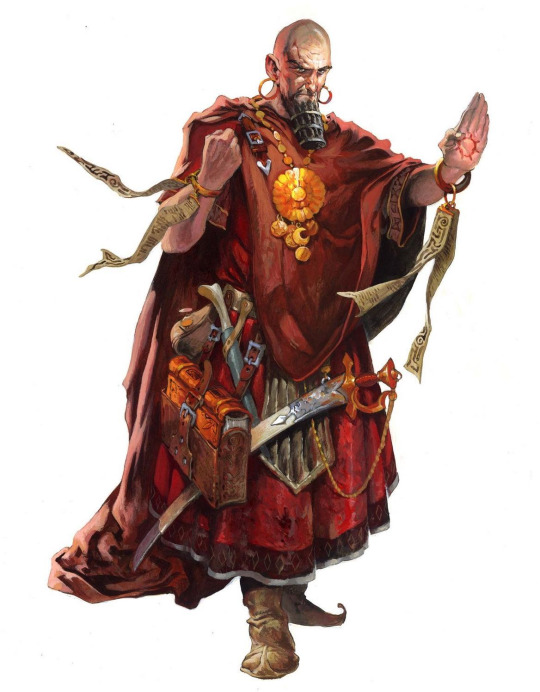
A Pocket Dimension
Milosh finds himself in, of all places, a brothel. It is being run by a strange man wearing all red, who is shocked, but not unhappy to have a customer. A few questions later, the group realizes this is Immerstal the Red, old party buddy of Aldric, who the group last saw on board the Surveyor’s ship, before he was sucked back into his pocket brothel.
Honestly, this scene is totally unplanned. I didn’t think Milosh would end up in the Ethereal but once he was there, someone (I can’t recall who had the idea, myself or one of the players) mentions our old NPC, Immerstal the Red, and it just was too perfect to not bring him back into the game.
Immerstal reveals he knew Aldric, and is shocked and saddened to hear of his passing. But he doesn’t seem that interested in returning to Faerun. Things are simpler in his pocket brothel, after all, and he is not sure it is wise to bring himself back to a world which, by all accounts, is about to be eradicated.
"Anyway,” he says, “they should just throw Immerstal’s old Fireball spells at the brute. That will show him.”
“The what now?” Milosh asks.
Immerstal blinks in surprise. “You haven’t heard of Immerstal’s mighty Fireblast?”
It turns out there’s a lot of Immerstal stuff that people haven’t heard of, or have forgotten. Sensing a weakness, Milosh plays this up, saying it’s too bad Immerstal won’t be coming back to remind the world who he was. Too bad history will forget him. This finally pushes Immerstal over the edge and he begins packing a bag, and pulls Milosh with him through a portal back to Waterdeep.
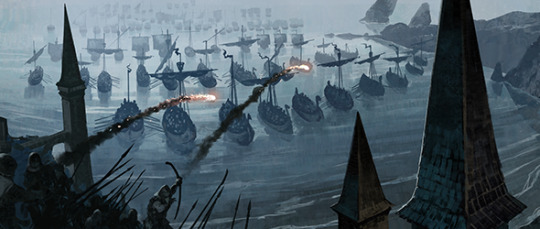
Wrapping up Waterdeep
A few final things wrap up our time in Waterdeep and prepare us for the final two sessions of our RPG. In the days that follow, It is revealed that Vindass Lanteral has fled the city, his fake Blackstaff broken. He is out of our game, and never does make a reappearance, at least not in our tales.
With the former blackstaff fled, Waterdeep is in political confusion, but they rally around Breathgiver, the new and true Blackstaff. She immediately declares an end to the shadow lords of Waterdeep and says that from now on, Waterdeep will no longer have lords, but instead shall be led by a council of people from every walk of life, and the Blackstaff shall preside over the council with the wisdom of all its ancient holders. Even as she proclaims this, word comes from the city gates that the other members of the Alliance, including the refugees from Baldur’s Gate, have heard of the Tarasque’s defeat and have arrived to offer their strength in the fight to come.
There is not much time to celebrate or rebuild. The PCs need to get to Friezurazov and face Abenthy before he can revive the Tarasque. However, in the Tarasque’s attack, Waterdeep’s massive fleet was all but destroyed, and the PCs have only Argent to carry them to battle. The armies of Waterdeep cannot follow. It is a devastating blow, for alone they cannot hope to survive and bypass Abenthy’s army.
But then hope arrives from an entirely unlooked for place. A fleet of elven ships is spotted on the horizon. When they land, it is revealed to be the fleet of the Wood Elves of the Sword Coast, led by an old elf named Feluver. He is the brother of Trakki, our PC from many campaigns ago, who was lost during the Red Hand saga. Feluver says that for the first time in many years he had a prophetic dream, and in it Trakki told him to sail his ships to Waterdeep and prepare to fight that evil which had corrupted Trakki’s soul before he passed.
This, then, is the answer to how the armies will make it to Friezurazov, how they will bring the strength to stand against Abenthy, his undead and Yuan Ti, and whatever other defenses he has. This, then, is the true beginning of the end.
Next time, our penultimate session, A Clashing of Fates.
#Immerstal the Red#DND 5e#Campaign Journal#Alignment May Vary#Karina#Waterdeep#Statues of Waterdeep#Blackstaff#Tyranny of Dragons#Dungeons & Dragons#Yuan Ti
1 note
·
View note
Note
Top five underrated NPCs!
I’m terribly sorry for this taking so long! I literally did not see this until like yesterday. O_o
Also, I ended up focusing on Obsidian/BioWare, because if I’d started thinking about every NPC ever in existence, you would never get an answer. :p
Anyway, here goes:
1. Bao-Dur (Knights of the Old Republic II: The Sith Lords)
I suppose I could name any KotOR 2 character that isn’t Atton or HK-47 when it comes to being underrated. But man. Bao-Dur.
You crash land on Telos and after gaining consciousness you immediately run into this kind of weird engineer guy who seems to know you and calls you ‘General’. General, you think. Yes, I was a General… And it all starts coming back to you.
I try not to spoil too much, but out of all the tragic, broken characters of KotOR 2 (and they all are, one way or another), Bao-Dur’s story and how it connects to the Exile’s is possibly the most fascinating and harrowing one. There is a weight on their shoulders only they can truly know and share and it creates a love and loyalty, a bond that is beautiful in its utter, profound twistedness. It’s not a romance. It’s not even a tragedy. It’s something more abstract, like… a dirge, perhaps.
That got weird and pretentiously poetic, but I can’t explain it better.
2. Haer’Dalis (Baldur’s Gate II: The Shadows of Amn)
I understand why he’s not more popular, in a way. The BG games had a metric fuckton of characters to choose from, and you could only have five at a time (not as your chosen team of the moment, but basically at all) in your party, and stuff like alignment and stats and general usefulness held more weight in choosing the party members.
And since Haer’Dalis is a) Chaotic Neutral, which is tricky unless you’re playing the same alignment b) a bard, which as a class is kind of like a useless combination of sorcerer and thief c) a so-called Glass Cannon - terrific fighter who’s however out cold after a couple of punches d) kind of difficult to obtain - you have to save his pretty, pompous ass twice. Yeah. I understand.
But as a character? I frequently wonder who the hell even came up with him.A charming, blue-haired, entropy-loving hellspawn on a tournee with his plane-hopping theater group. Talks in riddles and rhymes, bestows avian-themed nicknames on his comrades, is confused by trees and literally laughs in the face of danger. Imagine Zevran from Dragon Age, but like 75% weirder (yes, both are also dual-wielding bi/pansexuals with pointy ears and facial markings, who will flirt with anything). He’s just… endlessly entertaining.
3. Ashley Williams (Mass Effect)
Ahh, Ash. I don’t actually know how unpopular she is in the fandom at large, but in the female-dominant Tumblr circles at least it’s exactly as you’d expect, and it’s not exactly helped by the fact the game literally forces you to choose between her and Kaidan (the sole male LI in ME1).
She’s not a perfect person or even a character, obviously, but don’t even try to tell me the flack she gets is not affected by the usual internalized misogyny running rampant in fandom. Or that things wouldn’t be very different if she and Kaidan were gender-swapped (I kind of think part of the problem is that they already exist in roles that are traditionally gendered differently, actually).
4. James Vega (Mass Effect)
This is partially on EA/BioWare for having so much of his background and characterization exist only in extended canon (for example, it gets barely more than a mention that he guarded Shepard for the six months of their incarceration, if even that?), but weirdly many just write him off as ‘human Krogan’, or ‘random generic tank with no personality’.
And I find that sad because I think Vega is one of the most interesting, layered and real characters in the entire series, and such a hoot as a part of the team if you take him along on the missions. I guess some have a problem with him calling femShep ‘Lola’- but if you tell him to stop that he 100% does, so I don’t even know. Also the friendship he can develop with Shep is nothing short of epic.
5. Wynne (Dragon Age)
I absolutely know why: she’s an older female character and therefore not a love interest or eye candy - and she even tells you she’s apprehensive about your relationship with your chosen LI.
A huge pity because she’s amazing, but what can you expect from a fandom that treats the games largely as a dating simulation - I mean, people game for their own reasons etc. but I’m always sorry for the writers for trying to do something interesting and different when it barely gets any attention or appreciation. Oh well.
#dracoslorean#q and a#top 5 meme#video games#knights of the old republic#baldur's gate#mass effect#dragon age
30 notes
·
View notes
Note
Omg a fellow Liriel Baenre fan hello!

Hi! There are dozens of us...dozens...lol
I just finished book 1 recently! Have you read them all?
3 notes
·
View notes
Text
Larian’s gorgeous Baldur’s Gate 3 looks to be a game of groundbreaking systemic depth • Eurogamer.net
It’s early days for Baldur’s Gate 3. An end of year release window seems to have leaked but there’s “no exact date” for when it’s coming out, according to developer-publisher Larian Studios, of Divinity: Original Sin and Original Sin 2 fame. And when it does come out – simultaneously on Google Stadia and Steam – it’ll be in early access first. Understandably, early access can seem a bit icky to some, but Larian’s argument for it seems fair enough: the game needs en-masse testing from its own audience if it’s ever going to come together, and having now seen a marathon, over three hours long presentation of live gameplay, I can see why. Baldur’s Gate 3 is a game with an extraordinary level of systemic depth and remarkable complexity. Across the board it’s a game that’ll need time. Time to polish, time to balance, and quite a bit of time from the player, I’d imagine, to really get anywhere close to understanding and mastering its systems. But from what was shown of the game and what Larian has told us in our Baldur’s Gate 3 interview, it’ll be worth the wait – and then some.
Baldur’s Gate 3
Developer: Larian Studios
Publisher: Larian Studios
Platform: PC (Steam), Stadia
Availability: Early Access “later this year”.
Our presentation opened with the same stupidly pretty CGI intro you’ll have seen from the Baldur’s Gate 3 panel going on at PAX, before a quick run through the character selector, a skip over the “secret” tutorial, a couple of hours of early game party-gathering and dungeon crawling, and then a closer look at a massive, later-game dungeon that showed all the flashy systems off with a little more depth. To start at the beginning though, on the most fundamental level, Baldur’s Gate 3 is a darker, more viscerally detailed story than what you might have been used to from Larian.
The story begins with a bunch of Mind Flayers – angry, definitely-not-Cthulhu squid people with some pretty gnarly magic powers – flying around in a jumbo squid mothership called a Nautiloid. On board, you and a handful of others are held prisoner and infected with what could more or less be described as brain worms: a “tadpole”, with lots of teeth, bores its way under your eyelid, through the back of your eye and into your brain. The Nautiloid crashes, you wash up on a spot of beach, and your mission is to find someone who can get that tadpole out of your head before it pops through your skull and rather gruesomely turns you into a Mind Flayer yourself. As I said: a bit darker than Divinity.
The tadpole does come with a special power though, which acts as one of Baldur’s Gate 3’s central gimmicks: you can sort of “mind meld” with anyone else who has one, and as well as the “origin characters”, plenty of characters around the world will turn out to have a pet tadpole of their own. (The character creator itself appears just as detailed as Original Sin 1 and 2. Origin characters and their special, fully-voiced, cutscened and backstoried facets return of course, and in the creator you can choose race and subrace, background, class, subclass, and just about everything else conceivable).
youtube
On the surface, much of the time the tadpole mind-melding boils down to the odd special dialogue option with fellow brain wormers, acting as sort of shortcuts through tricky conversations, in the vein of special origin character options that are seemingly always positive. But that’s a superficial explanation, really. The tadpoles are one part of a much wider set of systems – or perhaps more accurately, a wider web of sets of systems – that all play off one another with Larian’s now-typical panache. To get to the heart of how this little story gimmick plays into the wider game you need to go deeper, into what Baldur’s Gate 3 really is and how it really works.
What it is is complex. Start by thinking of a typical CRPG like Divinity: Original Sin, where the background numbers power the visible numbers, like your characters stats, which dictate your ability to navigate certain situations like persuading someone to let you out of prison through dialogue, or smash through a door with magic. All of the people-persuading and the door-smashing intertwines with a set of rules, which in the Original Sin games is built around surfaces and statuses. So, if the floor’s on fire and you throw some water on it, or cast a water-based spell at it, the fire and water turn to a lingering cloud of steam. Standing in the steam might do damage to you or cure you of an ailment or whatever else, depending on all the moving parts like what race you are and what innate traits you have, and so on.
The devious grease and fire trap in action (click to expand these images, and for better look at the UI behind our captions).
Now, intertwine those rules with the rules of Dungeons and Dragons, as they were back in the original Baldur’s Gate and Baldur’s Gate 2. You can dip weapons in flaming sconces to light them on fire, you can throw anything you have on your person (more on that in a bit) you can stack objects to create stairs (more on that too), and, above all, everything is powered by a D20 dice roll. Sometimes that’s behind the scenes, little formulae whirring away in the background as you walk around the world passing and failing perception checks for little hidden levers or pressure plates; or spotting or failing to spot facial twitches that reveal anxiety or anger in conversation, all the working-out of which viewable in a little bottom-right tooltip that lifts the mathematical bonnet. Most of the time, however, that dice roll is quite explicit. You roll for initiative on encountering enemies, according to things like who has the high ground or the element of surprise. You roll for explicit attempts to do things like persuade or intimidate in conversation, as well as the passive rolls in the background that might just pop something up. You roll, three times, to see just how “dead” you are when you’re downed: fail three and you’re dead for good (if you haven’t already been picked off, or if you haven’t got a resurrection scroll on some other party member to recover).
Stir all that together and what do you have? Chaos. Baldur’s Gate 3 is a molotov cocktail of a game, every action’s consequences shattering outwards, spreading and spurting across seemingly the entire length of a run through it. Take the experience we had, with Larian’s founder, Swen Vincke, taking control of the origin character Astarion, who’s a vampire spawn (like a vampire only he has a boss, who’s more of a proper vampire). Astarion, being a vampire, regularly has the option to just go ahead and feast on the neck of whoever he’s talking to. Most of the time that’s not a very good idea and there’s not a very good chance it’ll work, but if you want to try it, you can. To demonstrate this, Swen opted to chow down on a sleeping party member at your camp (you can make camp in most places to heal up, restore ability uses and so on). He needed to role an 18 or higher, out of 20, to succeed – the purposes of the demonstration was to show it was pretty tough – and of course he rolls a natural 20 and now we’re noshing on our mate, left the next day with an especially upbeat Asatarion and a very “tired” Cleric.
youtube
But that, really, is only the surface of what you can do – and more than that just how much the inherent chance-based systems of D&D affect an already complicated mesh of things you can do in games like Divinity. At the very beginning of our first playthrough, at what would be the first little tester battle after the tutorial, Vincke missed a shot that had a 90 percent chance to hit, scored a critical miss on what would’ve been a one-hit-kill spell, and got killed in one shot by a critical hit from the enemy. So we roll back through all the intro chat for another go and: two hits, two kills, enemies done and dealt with before they could even move.
In another skirmish, this time our party up to three members, against about four bandit grunts, Vincke showed off the game’s new stealth system, sneaking Astarion up behind an archer that would have had an incredible high-ground advantage to punt him off the ledge before the battle begins. Again though: bad luck. Misses and critical hits in all the wrong directions mean that, even including the tactical ledge-punt, the battle goes horrifically and we’re left kiting the bandits out into the woods towards some neutral fighters nearby, in the hope they’ll join in. A magical, disembodied hand was used to try and nudge someone off another ledge but missed. Potions were used up, abilities spent, and Astarion left to throw his boots at an enemy for a bit of chip damage – and hits. Half-triggering the nearby group of neutrals changes how we meet them later on, forcing us to fight the last one instead of triggering a cutscene. Some party members are lost for good. Some secrets, hidden in plain sight just off the beaten path, through some bushes and under some noticeably odd-looking rock, go undiscovered. The point above all is luck can swing a playthrough to the wildest extremes of success and failure. Enjoying that will come down to how happy you are to improvise, make do and fly by the seat of your throwable boots. Or how regularly you like to save.
There’s 4 player online co-op, and two-player couch co-op confirmed by Larian so far.
There’s another rather ingenious twist to all this, too, which that bandit skirmish hinted at. You can split your party and put any of them into turn-based mode at one point, while the others can simultaneously walk around in “real time”. Baldur’s Gate 3 is technically a turn-based game. The combat is turn-based, dialogue is turn-based, so to speak, and the environmental puzzles, of which there seem to be many, are solved in that manner too. But you move around the world in real time and this system, really, is a bit of a hybrid. In our playthrough Astarion wandered down into a dungeon – previously guarded by those bandits – on his own, and worked his way through most if it solo while the others were left presumably frozen up on the surface. Then we got stuck in some combat after some more bad luck, including a key that failed to open a chest it should’ve (and an attempt to smash the chest open that just… smashed the chest entirely), and had to bring in some help. So back up on the surface another party member smashed through the ground they were standing on to drop down, conveniently, into a room next door to this tricky battle – a spot of movie magic, I’d suspect: “oh no it’s going wrong in exactly the right place, we definitely didn’t plan for this as a way to show you how the hybrid system works!” – and so we turn a 2v1 into a 2v2, that additional party member automatically entering turn-based mode when he reached the “battle area”.
Later in that dungeon we got stuck in a particularly grisly grease and fire-based trap (with a dash of raising the undead thrown in for good measure) and again Vincke demonstrated the power of lateral thinking by juggling real-time and turn-based movement to bring other party members to join and work around the hazards. Often that actually descends into a sort of calculated gaming of the game itself, and fascinatingly that seems to be where the game really finds its groove. Baldur’s Gate 3’s magic is in its malleability, but also in your malleability, as a player that has to react and adapt. You are supposed to try and break it. You’re supposed to build a staircase of crates the other side of a door to an enemy and keep popping it open and closed to confuse them and juggle the aggro. You’re supposed to see what happens when you throw this at that, cast this on them, say this to her or climb up onto that.
The elaborate verticality in action, as our party splits and sneaks through a multi-floored dungeon.
Which brings us to the climbing, and perhaps the biggest shift in how CRPG regulars will need to work their way through Baldur’s Gate 3: its fascinating use of verticality. Your characters can now all jump quite a significant way – success depending on, you guessed it, character stats and semi-hidden D20s – and so even in towns and hubs you can work your way onto a building and down into it through the roof, bypassing locked doors or barred gates. In the later-game dungeon we played, you’re tasked with tackling a tough boss surrounded by enemies. He’s got a tadpole himself, but try to use that in dialogue and, unless you’re lucky with the dice, it’ll probably fail, leaving him angry and you exposed to a pretty nasty ambush. So what do you do?
Well, if you picked up some interesting-looking barrels several hours ago, you could use them to create sort of veil of darkness to sneak up behind him. Things – obviously – went wrong when this was attempted in our playthrough so again, improvisation. The stealthiest character was sent up to the rafters – this must be the third or fourth level up of at least a four or five level dungeon – and around beside the boss. A very risky jump is attempted, to right behind him, and somehow pulled off. An explosive barrel is placed, and the our rogue Astarion works his way out up the other side, knocking down the escape ladder with him. Then the conversation, which our other party members had seemingly been paused in, half-way through, this entire time, can play out. Mind-meld fails, boss gets angry – planted explosive barrel gets detonated! – and he goes flying across the room and through a hole, down three floors to some giant spiders in the basement. Carnage – but all predicated on a decision to pick up some barrels hours earlier, your own ingenuity to think of it, your knowledge of how the systems themselves can be gamed, and the luck to pull it off.
from EnterGamingXP https://entergamingxp.com/2020/02/larians-gorgeous-baldurs-gate-3-looks-to-be-a-game-of-groundbreaking-systemic-depth-%e2%80%a2-eurogamer-net/?utm_source=rss&utm_medium=rss&utm_campaign=larians-gorgeous-baldurs-gate-3-looks-to-be-a-game-of-groundbreaking-systemic-depth-%25e2%2580%25a2-eurogamer-net
0 notes
Text
What Song?
So, a little game - what song encapsulates your Tav/Durge? Post a picture of them, their name and class and a link to the song that represents them with the reason why.

thanks for the tag @mynthara (starting a new chain xD)
Tav'Lyn Faen Tlabbar...Cleric of Lolth Eilistraee
Take my hand, I'm sinking, I'm reaching out for you Can't you see what you've done to all of us? Torturing me has no use here anymore I followed your rules A willing fool Branded by shame
tagging @communistfries @meishuu @psalacanthea @lazysload @its-tricky-to-save-baldurs-gate
@aldanil @primal-savagery @goromimii
#my oc: Tav'Lyn#this was fun i have a bunch of songs#although not one of my fav epicas the lyrics are on point#drow tav#Spotify
13 notes
·
View notes